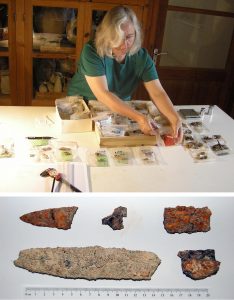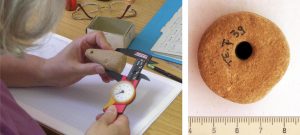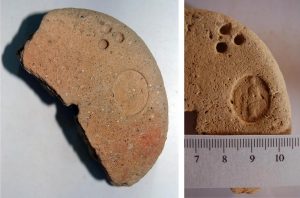
2019 STUDY OF COLLECTIONS FELLOWSHIP REPORT: JOANNA SMITH
Weighty Matters
In May and June of 2019 I studied objects connected with Iron Age Cypriot textile production. Research for this project began during study seasons on Cyprus in Polis Chrysochous (ancient Marion and Arsinoe) where I have been a long-time member of the Princeton University excavation team. Each year since 2014 while doing inventories of the finds I have documented textile tools from across the excavations. These tools come from workshop and household contexts ranging in date from the Cypro-Geometric to the early Hellenistic period. Primarily they were made and used by people who lived in the ancient city of Marion. Some tools attest to continuity in craft production in the city even after its destruction by King Ptolemy I, Soter, in 312 BCE. The ASOR Collections Fellowship gave me the opportunity to continue study of the tools in Polis and to study assemblages of textile tools from three other contemporary Cypriot settlements, Kition, Kouklia, and Kourion, in order to have more of an island-wide view of Cypriot Iron Age textiles. Locating and rediscovering objects held in the storerooms of the museums of Cyprus was just as eye-opening as unearthing objects during field excavation.

Top, Joanna S. Smith working with metal tools in the Local Museum of Marion and Arsinoe (Polis Chrysochous). Below, a series of iron sword fragments from Area E.F2 (trench r09, 1986).
Among the tools I studied are whorls for spinning, weights that held down warp fibers on looms, and dyestuffs such as crushed murex for the color purple. Yet textile tools can take unexpected forms. An object may seem unconnected when taken in isolation, but when seen in view of its archeological context it can reveal whole new meaning. A case in point comes from Polis. To understand the textile-working contexts there better in 2018 I began to look back through all the other associated finds and found several fragmentary iron sword blades. In 2019 I reexamined all the metal finds and confirmed that the find contexts of all the swords are the same as the contexts with the largest concentrations of whorls, loom weights, and dyestuffs.
Some fragments have the distinctive squared tip of a weaving sword (see Laura Mazow 2017 in Archaeological Textiles Review). Weaving swords were used to pack or beat in weft fibers woven through the warp threads strung on the loom. Some blade fragments have a triangular tip, more like a combat sword. Possibly weavers were reusing and refashioning weapons. These are the first weaving swords yet identified in any Mediterranean workshop context.
Fiber arts rarely survive in the archaeological record in climates subject to extremes of hot and cold, and damp and dry weather. To figure out what kinds of fibers and fabrics were made, it is important to know the weights of the tools used and key measurements such as spindle whorl diameter and loom weight thickness. Whorl weight, diameter, and shape determine the weight and tightness of the spun thread. The weight and width of a loom weight indicate the density and weight of the warp thread count in a fabric. Even these simple measurements, however, can raise questions. For example, some loom weights tend to rotate when hung on the loom becoming ever more rounded on the edges over time. This is especially the case with pyramidal weights, such as this example from Kition-Kathari.

At left, measuring one possibility for the width of a truncated pyramidal loom weight from Kition-Kathari (Kit-II/3898). At right, a cylindrical loom weight from Kouklia-Evreti (TE F 39).
Thus, one must explore the range of possibilities through multiple measurements. This observation helped to explain the enduring popularity of another weight shape, the flat disc or short cylinder. Weights of this shape vary widely in size and quality of crafting. Some weigh nearly 500 grams, while others are less than 40 grams, as with this example from Kouklia-Evreti. Yet short cylindrical weights would have hung on the loom in a predictable way, with their flat sides next to one another. Cloth woven with these weights ranges from light-weight and gauzy to heavy and dense, perhaps sail cloth.

At left, a broken cylindrical loom weight marked with three impressed dots and a seal-ring impression from the Kourion acropolis (Penn excavations no. Mi 387). At right, detail of the seal-ring impression: standing Aphrodite, at right, and a standing Eros with large wing, at left.
Few spindle whorls come from these settlement sites. Some spinning tools were placed in tombs and may have been linked closely with their owners, while weaving tools rarely accompanied people to the grave. Close observation and handling of many loom weights caused me to wonder what their makers/owners/users thought about them. The cylindrical weights cited above are especially telling. Over the course of the first millennium BCE these weights were made in an increasingly sturdy fashion, changing from expedient and lumpy unfired clay objects, to low-fired and smoothed terracotta, to hard-fired ceramics with more sharply defined edges. Labeling of these weights with seal rings and other marks is only a feature of the more permanent, fired weights. Initially people placed stamps on the curved surfaces that could be seen while weaving, suggesting a practical as well as perhaps a personal connection. People marked the high-fired late Classical and Hellenistic period weights, however, on the flat surfaces, as on this fragmentary example found by the University of Pennsylvania team on the Kourion acropolis.
These marks were hidden when weights were in use on the loom, which suggests that such marks were more personal than practical. The stamped seal-ring designs are not always easily legible; raking light, however, clearly reveals this ring’s design of Aphrodite and Eros, a fitting and exciting find during a season of study on the island of Cyprus.
Joanna S. Smith the co-Director of the Princeton Cyprus Expedition and a Consulting Scholar in the Mediterranean Section at the Penn Museum. She currently works as the Consulting Curator of Ancient Art at The John and Mable Ringling Museum of Art in Sarasota, Florida, and the copy-editor of the Kyrenia Ship Project.